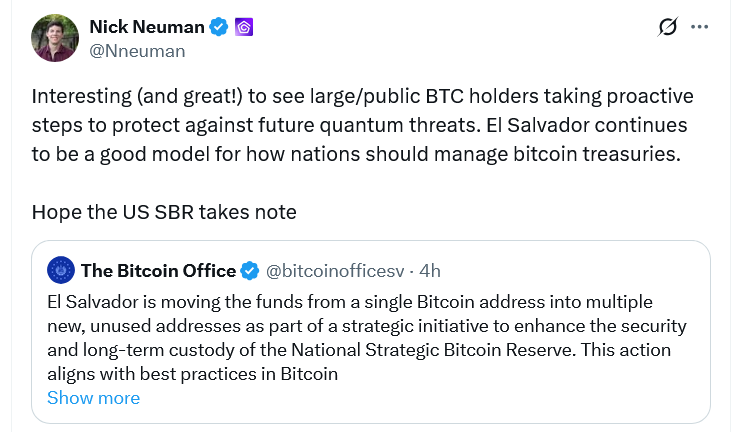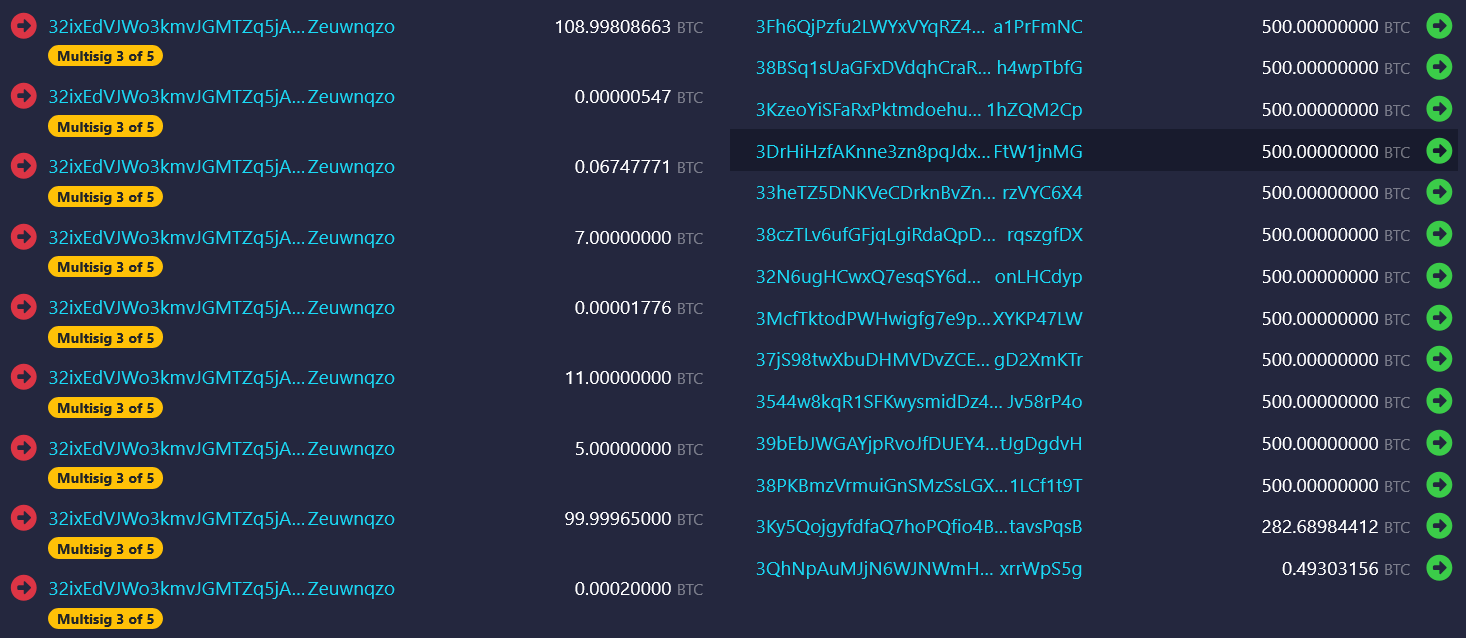El Salvador Transfers 6,274 Bitcoin Into 14 Wallets as Precaution Against Potential Quantum Attack
BTC
BTC/USDT
$29,363,495,952.18
$94,444.44 / $91,262.94
Change: $3,181.50 (3.49%)
+0.0071%
Longs pay
Contents
El Salvador transferred its 6,274 Bitcoin into 14 new wallet addresses as a precaution against future quantum-computing threats. The move reduces exposure by splitting large funds across multiple addresses so any single compromised key would affect only a portion of the reserve.
-
Security-first redistribution: 6,274 BTC moved into 14 addresses
-
Each address holds up to 500 BTC to limit single-address exposure
-
Quantum risk remains theoretical today; Project Eleven and industry experts note practical threat is not imminent
El Salvador Bitcoin transfer: 6,274 BTC moved into 14 addresses to reduce quantum risk — read the security rationale and key takeaways.
El Salvador has redistributed its Bitcoin reserve holdings into 14 new wallet addresses as a precaution against potential quantum computing threats.
El Salvador has redistributed its Bitcoin reserve holdings into 14 new wallet addresses as a precaution against potential quantum computing threats.
“By splitting funds into smaller amounts, the impact of a potential quantum attack is minimized,” El Salvador’s Bitcoin Office said in a post on X, adding that each Bitcoin (BTC) address holds up to 500 BTC.
The Bitcoin Office explained that once funds are spent from a Bitcoin address, its public keys are revealed and vulnerable — making it a target for quantum computers to crack — should the technology evolve into a significant threat in the future.

Project Eleven, a quantum research company, warned in April that more than 6 million Bitcoin — roughly valued at hundreds of billions of dollars — could be at theoretical risk if quantum computers eventually crack elliptic curve cryptography (ECC) keys.
What did El Salvador do with its Bitcoin reserves?
El Salvador moved 6,274 BTC from a single address into 14 separate addresses to reduce single-point exposure to future quantum threats. The redistribution keeps individual address balances below 500 BTC and preserves onchain traceability while mitigating risk from potential key-recovery attacks.
How does splitting addresses reduce quantum risk?
Splitting funds limits the amount accessible if a single private key is later compromised. Each time an address is spent from, its public key becomes known onchain and could become a target for a future quantum attack. Smaller balances per address reduce potential loss and ease migration to quantum-resistant keys.
Current context: Bitcoin private keys are 256-bit and no quantum system has approached the necessary scale. Project Eleven and other researchers note Shor’s algorithm application to ECC is not yet practical; even so, custodians and sovereign holders are preparing defensively.
The Bitcoin Office’s decision follows onchain data showing the 6,274 BTC stash (previously visible in one address) was redistributed into 14 new addresses on Friday.

Why is quantum computing discussed as a future risk to Bitcoin?
Quantum computing can theoretically break ECC by running algorithms such as Shor’s, which would enable deriving private keys from public keys. Presently, practical demonstrations remain far from the 256-bit scale used by Bitcoin, so the risk is considered long-term rather than immediate by most cryptographers.
Industry voices including Michael Saylor have characterized quantum threat headlines as premature, arguing that protocol upgrades and hardware changes can address vulnerabilities ahead of any practical threat. Official research bodies and private quantum firms continue to track progress and publish findings in plain text reports.
Frequently Asked Questions
Has El Salvador explained why each address holds up to 500 BTC?
Yes. Keeping balances under 500 BTC reduces the potential loss if a single address key were later compromised and simplifies risk management and potential future migrations to quantum-resistant key schemes.
Is Bitcoin currently vulnerable to quantum computers?
No. Current quantum systems have not demonstrated the capacity to break Bitcoin’s 256-bit keys; researchers state the threat is theoretical at present and would require advances years away from production-scale attacks.
Key Takeaways
- Proactive security: El Salvador redistributed 6,274 BTC into 14 addresses to reduce exposure.
- Risk assessment: Quantum threat is real conceptually but not practical today, according to Project Eleven and industry experts.
- Actionable steps: Splitting balances, avoiding address reuse, and planning migrations are prudent custodial practices.
Conclusion
El Salvador’s redistribution of its 6,274 BTC into 14 addresses emphasizes defensive custodial practices against theoretical quantum risks. The move is precautionary and aligned with recommendations from cryptography researchers and industry custodians. Observers should watch research updates and protocol developments while custodians continue to reduce single-address concentrations.
Jocelyn Blake
Comments
Yorumlar
Other Articles
Bitcoin Surges to $93,888: How Venezuela-US Tensions Triggered a Crypto Rally
January 5, 2026 at 07:04 AM UTC
Tether Adds Nearly 9,000 Bitcoin to Reserves in Q4 2025, Reaching 96,185 BTC
January 1, 2026 at 03:25 PM UTC
Bitcoin’s Potential 2026 Rebound Debated Amid Bottoming Signals
January 1, 2026 at 12:16 PM UTC
